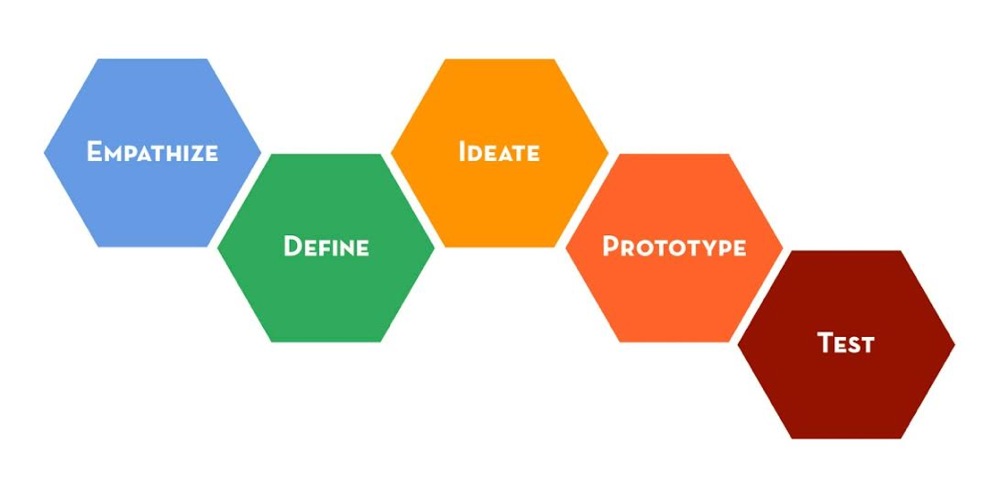
Design Thinking
Many of the world’s leading organizations are making a shift from their traditional way of working to adopt a more customer centric approach. Historically, development has been process driven and geared towards accomplishing metric based objectives. Over time this approach created a dilemma. As the needs of society continue to evolve at a rapid pace organizations have faced the complex challenge of consistently developing market leading solutions while simultaneously delivering an intuitive and modern user experience. With the rate of change proving to be problematic, design thinking was introduced to help business keep pace. Design thinking focuses on forming an understanding of people’s actual needs and then creatively unearthing a means of serving them. This school of thought takes an empathetic approach towards solution development. Users are involved at every point in the process and contribute to the development of the customer journey map. The result? A simpler, more engaging, and more pleasurable user experience.
A new voice in the conversation
The aforementioned customer journey map facilitates consistently great customer experience across all touch points in the company. Customer journey mapping is an essential element of the design thinking philosophy as it encircles the entire organization around the customer. Doing this puts the user at the forefront of development, which ensures that the customer will be more satisfied with what has been developed. The focus of the conversation is therefore shifted away from functional requirements to the thoughts and feelings of the individual who will end up using the solution.
While there is no standardized framework for design thinking, there are some general elements that seem to hold true wherever it is used. Learning from people is an essential part of the process. All those involved must subscribe to the idea of the business being a learning organization that continually transforms itself and constantly integrates the perspectives of the customer. Patterns must be recognized from this feedback, as they will point to the opportunities that can be capitalized on to benefit the target market. Certain design principles must then be put into place, as they will serve as the guideposts for the experience that is to be developed. Transforming these principles into specific ideas will be accomplished by the development of prototypes that will bring these ideas to life. The customer is involved during rigorous iterations where the solution is tweaked until it meets their needs. Consequently the voice of the user becomes the driving force of the creative process.
Design thinking in practice
Starting with the customer is a core pillar of one of the world’s favourite companies, Apple. Founder Steve Jobs integrated the customer experience into the design and development of their products, and this is one of the reasons why Apple became such a valuable company. Focusing on what actually works best for customers and not just the latest trends has consistently kept the Silicon Valley giant one step ahead of their competitors. One of the lesser-mentioned successes of their design thinking is perhaps their retail store. While many of their rivals such as Dell focused on online channels, Apple identified the need for consumers to interact with products and people in a physical space when making their purchase decision. A number of companies have since followed suit.
Employees are also beneficiaries of the design thinking process and must be treated as internal customers. Coca Cola uses the design thinking approach to reimagine the experience that their staff have when using services critical to their daily work. At the core of their service design philosophy they wanted to make something that was relevant and easy to use, implement a human touch in the digital world the customers work in, make sure the employees enjoyed working in the environment, and ultimately deliver a delightful experience. Similarly to Apple, the customer’s actual needs rather than their perceived needs were put at the core of the design and as a result they created new services based on insights gained from the customers including an improved experience when using internal sites and digital resources.
A whole company strategy
Design thinking is a great way for getting you closer to your customers by putting them at the centre of your business. It leads to incremental innovation as customer insights are used to nurture the development of the new solution. Companies who are aiming for the sort of innovation that makes a dent in the universe may not initially see the benefit of design thinking until a minimum viable product has been established. Consider the case of augmented reality devices such as Google glass, which firstly had to be created before users could imagine applications for it thus allowing the customer led iterative approach to begin. To make design thinking stick it must become ingrained in the DNA of a company and not just aimed at specific projects to spur the perpetual reinvention that keeps up with the changing needs of its internal and external customers.
